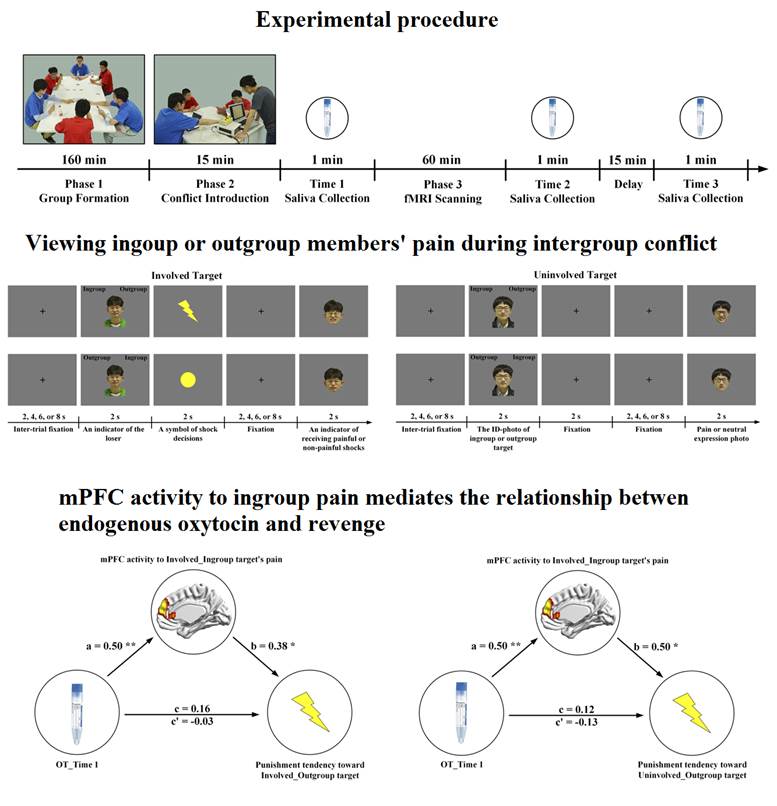Viewing ingroup members' pain caused by outgroup members can activate retaliation upon the outgroup. Such revenge behaviors occur widely in human history. To clarify the mechanisms underlying revenge behaviors is of both theoretical and practical importance. Previous behavioral research suggests contribution of both ingroup love and outgroup hate to revenge. The underlying neurobiological mechanisms, however, remain unclear. Shihui Han and colleagues previous reported racial ingroup favoritism in empathic neural responses to others' pain (Xu et al., 2009, Journal of Neuroscience,Luo et al., 2015, NeuroImage; Sheng et al., 2016, Cerebral Cortex) and oxytocin effects on racial bias in empathic neural responses (Sheng et al., 2013, Biological Psychology). They propose and provide evidence for an asymmetric race processing model of racial ingroup bias in empathy and altruistic behavior (Han, 2018, Trends in Cognitive Sciences; Zhou et al., 2020, Nature Human Behaviour). Based on the previous findings, they further investigated neurobiological correlates of revenge behavior during intergroup conflict by examining endogenous oxytocin and empathic brain activity. Their new findings are published in an article titled "A neurobiological association of revenge propensity during intergroup conflict" in eLife on March 3rd, 2020. They integrated functional MRI and measurements of endogenous oxytocin in participants who viewed an ingroup and an outgroup member's suffering that is caused mutually (Revenge group) or respectively by a computer (Control group). They found that intergroup conflict encountered by the Revenge group was associated with an increased level of oxytocin in saliva compared to in the Control group. Furthermore, the medial prefrontal activity in response to ingroup pain in the Revenge but not Control group mediates the association between endogenous oxytocin and the propensity to give painful electric shocks to outgroup members regardless of whether they were directly involved in the conflict. These findings highlight an important neurobiological correlate of revenge propensity, which may be implicated in conflict contagion across individuals in the context of intergroup conflict. This work was supported by the National Natural Science Foundation of China.
References
Xu, X., Zuo, X., Wang, X., Han, S. (2009). Do you feel my pain? Racial group membership modulates empathic neural responses, Journal of Neuroscience, 29, 8525-8529.
Sheng, F., Liu, Y., Zhou, B., Zhou, W., Han, S. (2013). Oxytocin modulates the racial bias in neural responses to others’ suffering. Biological Psychology, 92, 380-386.
Luo, S., Li, B., Ma, Y., Zhang, W., Rao, Y., Han, S. (2015). Oxytocin receptor gene and racial ingroup bias in empathy-related brain activity. NeuroImage, 110, 22-31.
Sheng, F., Han, X., Han, S. (2016). Dissociated neural representations of pain expressions of different races. Cerebral Cortex, 26, 1221-1233.
Han, S. (2018). Neurocognitive basis of racial ingroup bias in empathy. Trends in Cognitive Sciences, 22, 400-421.
Zhou, Y., Gao, T., Zhang, T., Li, W., Wu, T., Han, X., Han, S. (2020). Neural dynamics of racial categorization predicts racial bias in face recognition and altruism. Nature Human Behaviour, 4, 69-87.
Han, X., Gelfand, M. J., Wu, B., Zhang, T., Li, W., Gao, T., Pang, C.,Wu, T., Zhou, Y., Zhou, S., Wu, X., Han, S. (2020). A neurobiological association of revenge propensity during intergroup conflict. eLife, in press.



